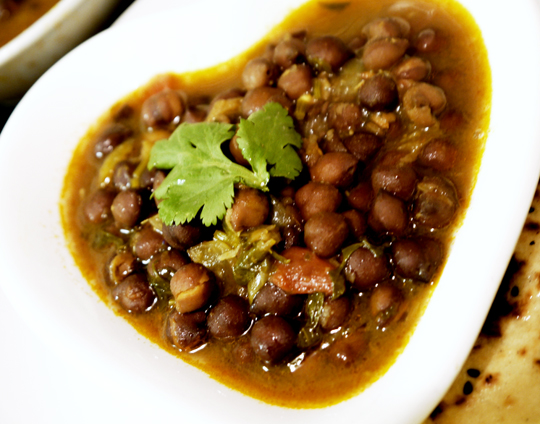Mama’s Punjabi Recipes: Kale Channe Turi Wale (Black Chicpea Curry)
Most people are used to eating safayd chole (white chickpeas) in restaurants and at home; and even at mandirs and gurdwaras where they are served after services. Chole are fairly cheap, are readily available pre-boiled in cans so they are easy to make and are filling and a good source of protein. Even with a little effort, and the right spices of course, you can’t go wrong with them and can feed a lot of people quickly.
But there is another type of chole – the kale channe (black chickpeas) which are less often cooked but are just as easy to make, are very flavorful, are actually a better source of protein and are easier to digest. They are smaller and harder than their white cousins and are covered with a reddish brown skin.
Many people eat the dry kale channe dish traditionally during the Navratri and Durga Puja season and otherwise it is mostly eaten as a snack with puris or kulchas and many hawkers serve them North India also because it is inexpensive, fairly easy to make and a quick form of high protein for vegetarians. Hawkers also sell them roasted as a snack, much like peanuts, in paper cones and the crispy red skin crackles off. Roasted and skinless kale channe are usually ground up to make besan, the flour that is used in so many Indian dishes.
Like safayd chole, the hard dry kale channe bean is softened either by boiling them in a pressure cooker or by soaking them overnight in a bowl of water and then boil them in a pot for a few hours the next day. But, whereas the water used to boil safayd chole is usually thrown away, the water from boiling kale channe doesn’t contain starch and is used to make the thin curry that is used for the dish. When serving, sprinkle with chopped coriander leaves and serve garnishes on the side like raw onions and with long, spicy green Indian mirchen (chilli peppers).
Ingredients :
2 cups kale channe (black chickpeas)
1 large piyaaz (onion)
1 medium clump of adrak (ginger root)
1 medium kernel of lasan (garlic)
1 tablespoon of vegetable or olive oil
Tomato paste to taste
5 cups of pani (water)
Spices (to taste): namak (salt), mirch (red pepper), garam masala
Garnishes (to taste): dhania (coriander) chopped leaves
Directions:
1. Wash the kale channe well, then pour into a pot and let them soak overnight in warm water.
2. Pour them with the water in a pressure cooker and bring to a boil; wait you get 5 or 6 whistles before opening the cooker up. They are usually well cooked after 6 whistles. Do not add salt or baking soda when boiling the channe as they are naturally salty and the soda only upsets the stomach.
3. If you don’t have a pressure cooker, you can boil them in a full pot of water for at least 90 minutes under medium low heat. If you need to add more water when boiling, you can do so. Pour through a sieve and save the water to make the curry. The water is also often drunk as a thin soup.
4. Finely chop the ginger, onions and garlic. Throw them in a saucepan and brown them in the oil.
5. Add half a tablespoon of tomato paste, to enhance the taste, texture and add red color and stir in.
6. Throw in the boiled channe and then mix well with the masala over medium heat for 5 minutes to roast them and let the masala seep in, making sure that the channe do not stick or burn.
7. Now pour in ¾ of the saved water and bring the channe to a boil. Save the rest of the water in case you need to add more.
8. The curry is usually much thinner than for chole, so to thicken it a bit, take a half cup of the channe, mash them, then add back to the hot curry.
9. Turn the heat to low for 5 minutes to let the curry soak into the channe. When it has cooled down a little, add the garam masala and dhania and mix well.
10. Turn the heat off, cover the pot and let it sit for 5 minutes. Eat with roti, naan or rice.
MAMA’S TIP OF THE WEEK
HEAVY, THICK BOTTOMED POTS ARE BEST TO BOIL CURRIES
Cooking well requires not only a good knowledge of vegetables and spices but also timing and the amount of heat to use at different stages of preparation. To this, you should add that an appreciation of the type of utensil you use is just as important. A wide mouthed kadai (wok), for example, will let out heat so that the food, like a gajjar halva (carrot pudding) won’t stick. Similarly, using a heavy bottomed, thick pot will allow the heat to spread across the bottom and is best for boiling curries so they won’t stick and burn.
Shakuntla Malhotra is a skilled cook of Punjabi dishes made in the old-fashioned style that she learnt as a young woman in her ancestral home in Lyallpur, India before it became part of Pakistan after the Partition in 1947. People have often admired her cooking for its simplicity and taste that comes with each mouthful. Even in her mid-eighties, she continues to cook daily and agreed to share some of her delectable Punjabi recipes.


